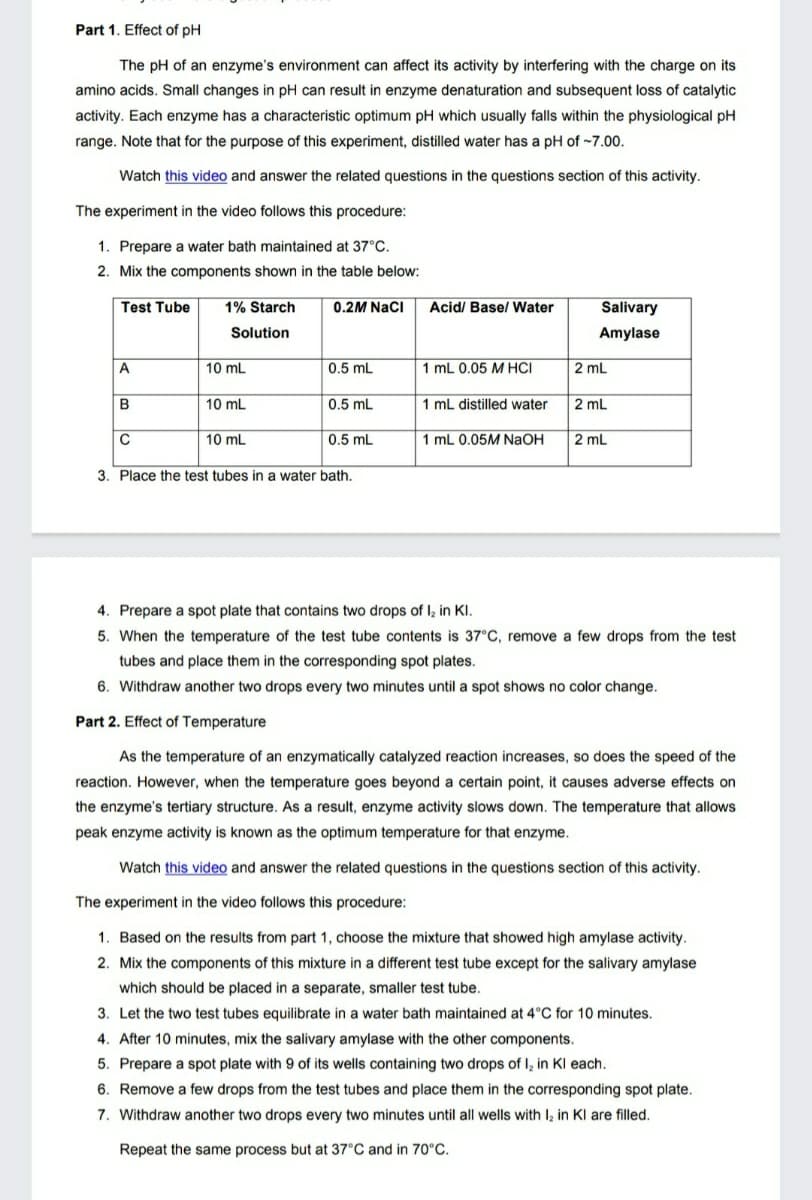What reaction was catalyzed by salivary amylase?
Biology (MindTap Course List)
11th Edition
ISBN:9781337392938
Author:Eldra Solomon, Charles Martin, Diana W. Martin, Linda R. Berg
Publisher:Eldra Solomon, Charles Martin, Diana W. Martin, Linda R. Berg
Chapter7: Energy And Metabolism
Section: Chapter Questions
Problem 11TYU: PREDICT In the following reaction series, which enzyme(s) is/are most likely to have an allosteric...
Related questions
Question
What reaction was catalyzed by salivary amylase?

Transcribed Image Text:Part 1. Effect of pH
The pH of an enzyme's environment can affect its activity by interfering with the charge on its
amino acids. Small changes in pH can result in enzyme denaturation and subsequent loss of catalytic
activity. Each enzyme has a characteristic optimum pH which usually falls within the physiological pH
range. Note that for the purpose of this experiment, distilled water has a pH of -7.00.
Watch this video and answer the related questions in the questions section of this activity.
The experiment in the video follows this procedure:
1. Prepare a water bath maintained at 37°C.
2. Mix the components shown in the table below:
Test Tube
1% Starch
0.2M NacI
Acid/ Base/ Water
Salivary
Solution
Amylase
A
10 mL
0.5 mL
1 mL 0.05 M HCI
2 mL
В
10 mL
0.5 mL
1 mL distilled water
2 mL
C
10 mL
0.5 mL
1 mL 0.05M NaOH
2 ml
3. Place the test tubes in a water bath.
4. Prepare a spot plate that contains two drops of I, in KI.
5. When the temperature of the test tube contents is 37°C, remove a few drops from the test
tubes and place them in the corresponding spot plates.
6. Withdraw another two drops every two minutes until a spot shows no color change.
Part 2. Effect of Temperature
As the temperature of an enzymatically catalyzed reaction increases, so does the speed of the
reaction. However, when the temperature goes beyond a certain point, it causes adverse effects on
the enzyme's tertiary structure. As a result, enzyme activity slows down. The temperature that allows
peak enzyme activity is known as the optimum temperature for that enzyme.
Watch this video and answer the related questions in the questions section of this activity.
The experiment in the video follows this procedure:
1. Based on the results from part 1, choose the mixture that showed high amylase activity.
2. Mix the components of this mixture in a different test tube except for the salivary amylase
which should be placed in a separate, smaller test tube.
3. Let the two test tubes equilibrate in a water bath maintained at 4°C for 10 minutes.
4. After 10 minutes, mix the salivary amylase with the other components.
5. Prepare a spot plate with 9 of its wells containing two drops of I, in Kl each.
6. Remove a few drops from the test tubes and place them in the corresponding spot plate.
7. Withdraw another two drops every two minutes until all wells with I, in Kl are filled.
Repeat the same process but at 37°C and in 70°C.
Expert Solution
This question has been solved!
Explore an expertly crafted, step-by-step solution for a thorough understanding of key concepts.
This is a popular solution!
Trending now
This is a popular solution!
Step by step
Solved in 2 steps

Recommended textbooks for you

Biology (MindTap Course List)
Biology
ISBN:
9781337392938
Author:
Eldra Solomon, Charles Martin, Diana W. Martin, Linda R. Berg
Publisher:
Cengage Learning

Human Biology (MindTap Course List)
Biology
ISBN:
9781305112100
Author:
Cecie Starr, Beverly McMillan
Publisher:
Cengage Learning

Biology (MindTap Course List)
Biology
ISBN:
9781337392938
Author:
Eldra Solomon, Charles Martin, Diana W. Martin, Linda R. Berg
Publisher:
Cengage Learning

Human Biology (MindTap Course List)
Biology
ISBN:
9781305112100
Author:
Cecie Starr, Beverly McMillan
Publisher:
Cengage Learning